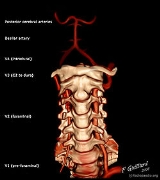
Vertebral artery
Overview
The vertebral arteries are major arteries
of the neck. They branch from the subclavian arteries
and merge to form the single midline basilar artery
in a complex called the vertebrobasilar system, which supplies blood to the posterior part of the circle of Willis
and thus significant portions of the brain
.
The vertebral arteries arise from the subclavian arteries, one on each side of the body, then enter deep to the transverse process of the level of the 6th cervical vertebrae
(C6).
Artery
Arteries are blood vessels that carry blood away from the heart. This blood is normally oxygenated, exceptions made for the pulmonary and umbilical arteries....
of the neck. They branch from the subclavian arteries
Subclavian artery
In human anatomy, the subclavian arteries are two major arteries of the upper thorax , below the clavicle . They receive blood from the top of the aorta...
and merge to form the single midline basilar artery
Basilar artery
In human anatomy, the basilar artery is one of the arteries that supplies the brain with oxygen-rich blood.The two vertebral arteries and the basilar artery are sometimes together called the vertebrobasilar system, which supplies blood to the posterior part of circle of Willis and anastomoses with...
in a complex called the vertebrobasilar system, which supplies blood to the posterior part of the circle of Willis
Circle of Willis
The Circle of Willis is a circle of arteries that supply blood to the brain...
and thus significant portions of the brain
Brain
The brain is the center of the nervous system in all vertebrate and most invertebrate animals—only a few primitive invertebrates such as sponges, jellyfish, sea squirts and starfishes do not have one. It is located in the head, usually close to primary sensory apparatus such as vision, hearing,...
.
The vertebral arteries arise from the subclavian arteries, one on each side of the body, then enter deep to the transverse process of the level of the 6th cervical vertebrae
Cervical vertebrae
In vertebrates, cervical vertebrae are those vertebrae immediately inferior to the skull.Thoracic vertebrae in all mammalian species are defined as those vertebrae that also carry a pair of ribs, and lie caudal to the cervical vertebrae. Further caudally follow the lumbar vertebrae, which also...
(C6).
Unanswered Questions

